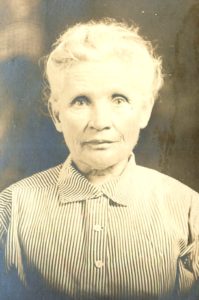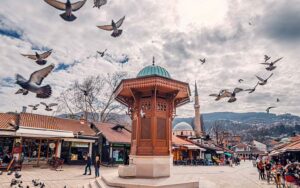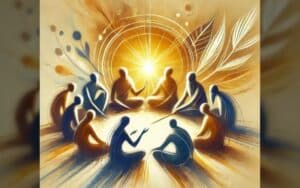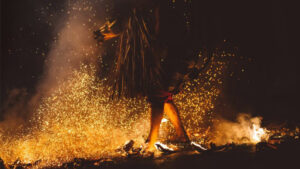En Español: Cinco Maneras de Honorar a Tus Ancestros.
We all have ancestors, both of blood and of spirit, and each of our lives rests firmly on the foundation of their sacrifice. They are as near to us as our breath and bones, and when related with in conscious ways, they can be a tremendous source of healing, guidance, and companionship. The ancestors we choose to honor may include not only recent and more distant family but also beloved friends and community, cultural and religious leaders, and even other-than-human kin such as companion animals. Our ancestors bring vital support to fulfill our potential here on Earth, and, through involvement in our lives, also further their own growth and maturation in the spirit realms.
Like the living, spirits of the deceased run the full spectrum from wise and loving to self-absorbed and harmful. Physical death is a major event for the soul, a rite of passage we will all face, and the living can provide critical momentum for the recently deceased to make the initiatory leap to become a helpful ancestor. Once the dead have become ancestors, part of their post-death journey may include making repairs for wrongs committed while here on Earth. For their sake and for ours, it’s good to spend a little time now and again feeding our relationships with the ancestors. The five suggestions below, none of which require belief in any specific tradition or dogma, are safe and effective ways to assist our beloved dead and to welcome the ongoing support and blessings of the ancestors in our everyday lives.
Fulfill Your Soul’s Purpose as an Ethical and Loving Person
The most important and most challenging way to honor our ancestors is to fulfill our personal potential and life’s purpose here on Earth. Many cultures maintain that we each have a unique destiny or karma to fulfill and that we ideally make it a high priority to remember these original instructions and do what is necessary to express our gifts, our true will, and our most authentic selves. The ancestors are seen as allies in this process of remembering and a reservoir of power and backing to help us embody our potential in this lifetime. Conversely, when we have lost touch with a sense of greater purpose, if we are fortunate, the ancestors may bring about life changes aimed to jar us into greater contact with our soul’s longing and increased awareness of the agreements made before our birth.
Talk of destiny and calling is all well and good; however, in reality it’s difficult to actualize our full potential until our life and relationships are more or less in order. This gradual and ongoing work of being a conscious person may include things like learning how to express emotions in healthy ways, committing to tell the truth in relationships, reaching out for necessary support to get sober, seeking education to better ourselves, taking better care of our bodies, and generally accepting greater responsibility for becoming a loving and reliable human being. Whatever helps us to become more ethical, balanced, and open-hearted people is one of the most powerful and sincere offerings we can make to our ancestors.
Ironically, the very things that would drag us down are often part of our inheritance from family ancestors. Alcoholism, patterns of physical and sexual abuse, emotional cruelty and dysfunction, religious extremism, racism, sexism, wounds related to money and poverty, predisposition to physical and mental illness, and a thousand and one other poisons can all be passed down along the bloodlines where they lay, seeds in our karmic profile that, if watered with the right conditions, may grow into full-blown dysfunction. If properly understood these challenges may implicitly point us in the direction of the antidote, often an internal resource that we also carry as a dormant ancestral inheritance. For example physical violence can be a distortion of the gift of healthy warriorship, fear of scarcity may mask an unhealed wound in a lineage of strong providers, or addiction could be a way of numbing the sensitivity required of healers, artists, and lovers. In this way, the ancestors can be both the source of the hardship and the remedy, yet every time we make the right choices when faced with these inherited patterns, we elevate both ourselves and their spirits.
Dedicate Positive Actions in the Name of the Ancestors
Nearly all traditions have some way of recognizing the spiritual benefit of good deeds and generosity. Charity in Christianity traditions, sadaqah in Islam, tzedakah in Judaism, and dana in Buddhism and Hinduism are but a few religious expressions of a nearly universal theme of practicing generosity and affirming our inter-relatedness with and care for others. Traditional, indigenous ways of life also tend to emphasize the need for sharing wealth and the blessings that flow from living a helpful, service-oriented life. Mongolian shaman Sarangerel, a friend and teacher who passed suddenly in 2006, half-jokingly described shamanism as the science of engineering hiimori or “windhorse,” and wrote that:
This force is housed within the chest and will vary in size according to how one uses and accumulates it. Very strong windhorse allows one to think clearly and analytically and see through deception. Windhorse is the power which allows shamans and other powerful people accomplish what needs to be done simply and easily….Use of one’s personal power toward harmful ends or to upset the balance of the universe depletes windhorse…Windhorse can be increased by actions to restore balance in the universe and through religious practice.[1]
In this way, engaging in loving and truly helpful actions results in the accumulation of tangible and usable energy in the energetic field or body of the one taking the action.
Most people instinctively grasp a related principle that the energetic effects of actions can, at least to some degree, be directed or linked to others who did not carry out the actions themselves. To illustrate this, imagine someone privately donating ten million dollars in your name toward feeding and housing the homeless in your area. Compare this with someone doing a private ritual to dedicate an impending act of genocide in your name; clearly less cool. In neither case are you the one carrying out the actions themselves. This principle is already widely applied through the practice of making charitable contributions in the name of the recently deceased by their loved ones.
Having a clear focus, a meaningful activity, and personally connecting with the process of elevating the consciousness of your beloved dead all help to enhance the effectiveness of this practice. For example, if you have the sense that your grandmother’s spirit is not at peace or if she is well and you just wish to celebrate her life and spirit, consider specifically dedicating a positive action to her rather than to all your ancestors in general. The more specific the target of the offering, the more concentrated the effects. Also, try to choose a type of service or action that fits the recipient’s unique life and spirit. If your father was racist or engaged in domestic violence, you might donate to a charitable organization working for racial healing or a battered women’s shelter. Likewise, if the deceased loved local wildflowers, a dedicated day of service to the Native Plant Society can enhance the intimacy, emotional charge, and effectiveness of the offering. Finally, taking the time to set clear intent and emotionally connect to the process can help insure the positive energy generated actually reaches the intended target.
Although more involved acts of service are fantastic, more simple dedications can also be powerful. For example, let’s say that I have a disturbing dream about my grandfather who died last month, and I’m left with the nagging sense that he may not have transitioned yet to the realm of the ancestors. Later in the morning I find myself at yoga class and the teacher invites us to dedicate our session of yoga to some specific intent. Remembering the dream, I pause and voice internally or quietly aloud, “I dedicate the positive energy from this session of yoga to the well-being of my grandfather; may his spirit be at peace and united with our loving ancestors.” Throughout the class I periodically hold him in my awareness, seeing him surrounded by love and light, and in this way reaffirm the link between me and the focus of my prayer. Finally, at the close of the class, I take a moment to visualize a sphere of light, the windhorse accumulated from this focused spiritual practice, and I envision this light surrounding the spirit of my grandfather, bringing him happiness and well-being. In this way, I couple the power of focused intent with the usable energy generated from a simple positive action in a way that is helpful and uplifting for my grandfather’s spirit. The dedication of merit from good deeds large and small is an especially effective practice for those ambivalent about the reality of the ancestors or who are not interested in direct spirit contact but still wish to honor the memory of their loved ones.
Stay Open to Direct Communication from the Ancestors
Direct contact with the spirits of the ancestors can be cultivated through ritual practices; however, communication may also happen spontaneously in forms such as dream contact, waking encounters, and synchronicity. When we have a framework to receive their outreach, their work is made easier and we are open to the enjoyment of conscious, ongoing relationship.
Talking or even just listening to dead people, even if they’re your beloved dead people, tends to raise a few eyebrows, and some of the concerns may be legitimate. With respect to hearing voices, the experience of communication with the deceased is almost never an indicator of a psychotic process or break with reality. If you or those around you have any doubts about whether or not you’re coming unglued, consider reaching out for support from a grounded ancestor specialist, spiritually-oriented psychotherapist, supportive mentor, or friend. The more common concern centers on distinguishing mental chatter from direct spirit contact, a refinement that I’ve found only comes with a balance of faith and healthy skepticism combined with practice over time.
Another important concern is making sure that you’re mostly engaging with loving, evolved ancestors and not with conflicted or even manipulative ghosts. If you have guides that you work with in spirit, call upon them to provide a second opinion on the ancestors contacting you to help insure they’re trustworthy. However, evolved and helpful ancestors may still lead with tough love and express themselves in rowdy and enigmatic ways, and telling the difference between the two again is something that comes with practice. Simply taking a moment to consult your personal instinct is often sufficient to determine if any spirit is basically loving and well-intended. As a general guideline, if your relationship with an ancestor is not helping you to be a more empowered, ethical, and loving person, seek a second opinion.
Dream Visitation
The ancestors can often reach even the most skeptical of descendants with a well-placed, emotionally charged dream. Not all dreams of the dead necessarily involve direct spirit contact, and discerning when an ancestor is actually trying to get through is not always easy; however, contact dreams are often accompanied by the felt sense of actually meeting with the deceased loved one. These dreams may include receiving a message or some kind of healing around the loss that accompanied the loved one’s death. If the dream has the quality of contact and the deceased seems in distress, you may offer direct prayer, healing ritual, and positive energy toward their elevation and happiness. If the ancestor seems well in spirit, simply being open to their visit supports future dream contact and other forms of relationship.
Waking Encounters
Sometimes, at the strangest moments, even for those who don’t believe in spirits or seek out contact with the ancestors, the dead just appear. They may come at times of crisis or intensity like near-death experiences or four hours into a strong acid trip, but more often they come in everyday moments; while driving, laying in bed before sleep, or out walking the dog. Sometimes these visitations can be subtle, and if we’re not careful we can easily dismiss them as mere imagination or fantasy. For most people these encounters are not visual and they may not even be auditory; usually there’s just a sense of someone being present for a moment, a direct knowing. For those with a formal practice of ancestor reverence or a strong link with the unseen realms, such encounters may be relatively common and are not necessarily charged with any more meaning than a phone call from a friend. Even if we never seek direct contact from our side, just keeping an open mind about the possibility of our beloved contacting us during our everyday life is a great way to honor our unbreakable bond with the ancestors and the other world.
Synchronicity
First popularized by Swiss psychologist Carl Jung, synchronicity refers to two or more events that are meaningfully related, but which otherwise would be unlikely to occur. Although a complex process to explain in logical terms, the implication is that the ancestors may also speak through events themselves. Suppose that your deceased partner loved lilacs and on the anniversary of her death you’re on the front porch having a drink and feeling particularly sad. At that moment your new neighbor walks over to share with you, out of the blue, that she’s thinking of planting a lilac bush and asks your opinion on the matter. You feel a chill pass through your body and a sense that something magical is happening, a temporary drawing close of the worlds. After the conversation, you’re left with a sense, against all logic, that your partner has reached out to comfort you. Meaningful songs on the radio, written signs and messages, and spontaneous animal encounters are but a few of the ways in which the ancestors shamelessly make use of our surroundings to generate meaningful events and get their point across.
Establish a Physical Place to Honor Your Ancestors
In my weekend ancestor trainings, I’ve often joked that if you don’t have an ancestor altar, you become the altar. Having a place to honor the dead can function as a kind of depossession. The underlying principle is that of letting go of an unconscious identification with the ancestors and assuming instead a stance of relationship. When we designate a physical place to honor our ancestors, they are externalized in this process, and their sanctified place then serves to remind us of the ongoing relationship. The physical place may become a location for in-dwelling, a spirit house, a sacred space in this world for the ancestral spirits, much in the same way that a crucifix, a statue of Krishna, or a copy of the Qur’an becomes infused with holy meaning both through our perception and also presumably through the agency of God, the gods, or the ancestors directly.
The location and nature of an ancestor-honoring place may vary widely according to tradition and personal style. Insofar as the bones of the dead can function as a kind of spirit house or energetic link with the soul of the deceased, places that house human remains (e.g., cemeteries, tombs, reliquaries, burial mounds) are natural points of physical contact with the ancestors. Specific trees, mountains, rivers, and other natural features may be culturally or personally related with as places of heightened connection with the ancestors. Ancestor veneration may also occur in places such as community temples and shrines, public monuments to the heroic dead, sacred groves, and other types of ritual spaces specifically consecrated for work with the dead. The most common type of place for honoring the spirits of the ancestors is likely the individual or family-level shrine, typically located in or near one’s place of residence. By anchoring the presence of the ancestors somewhere outside our bodies yet still in the physical world, we both externalize the dead and create conditions that support ongoing relationship.
If you feel guided to establish a personal ancestor altar in your home as a way to enhance your relationship with your beloved dead, remember that the shrine itself will ideally grow into a place where their energy dwells in a more concentrated way. For this reason, you may prefer to locate the shrine in a different room than where you sleep and somewhere out of the way or even contained like inside a cabinet, especially if your share your home with young children or rowdy pets. The altar may be a small table or shelf and can include images of the ancestors, stones, candles, colorful fabrics, incense, inherited objects from the deceased, inspired artwork, religious items familiar to your ancestors like a Bible or rosary, and other physical offerings. Some prefer to avoid having images of the living on their ancestor shrine, and although I personally follow this guideline, most important is to allow the ancestors themselves to guide you on where and how they want their place of honoring to be established.
Once the place of honoring is physically prepared, I recommend a simple ceremony of calling on the ancestors to activate and energize the shrine (see practice of “spirit feast” below for one example). Once activated, the altar becomes a place that exists in both worlds, a point of contact and heightened communion with your beloved dead. This does not mean the ancestors only dwell at the shrine any more than God only lives in churches, merely that the altar serves as a consecrated, physical declaration of relationship with the ancestors. From this beginning, the process of tending to these relationships can then be amplified and deepened.
If you ever decide that you no longer wish to work with the shrine, take a moment to explain to the ancestors your choice and to then mindfully undo what was done, gently closing through ritual action the gateway between the worlds that was opened when the altar was established. If you have specific traditions of ancestor reverence that inspire and instruct you on how to tend to an ancestor shrine, that’s fantastic, and from my perspective, the only “right way” is whatever truly helps you to have a sustained and heart-centered relationship with those that ancestors you honor at your personal altar.
Make Offerings to the Ancestors
Human lovers tend to appreciate a blend of respect, passion, kindness, and quality time with each other. Plants enjoy a nice balance of sun, moisture, and healthy soil. The Buddha seems to have a taste for incense while the love goddesses may favor honey, flowers, and all things sweet. Just as we feed our human relationships with particular kinds of attention, engagement, and gifts, so can relationships with the ancestors be fed through the practice of making intentional offerings. Acts of ritual feeding may underscore a request we are making of our ancestors, convey gratitude for support already received, or just be a way of sustaining the intimacy of ongoing relationship.
As a general progression, it’s a good idea to first determine what kind of offering is called for. Then present the offering along with your intention, after which you may inquire as to whether the offering has been received well. Finally stay open to guidance or ripple effects such as intuitive communications, messages in dreams, or other signs from the ancestors. Physical offerings may include food, drink, coins, cloth, tobacco, ash, tears, stones and other found objects, flowers, fire, and creations made with our hands. Offerings to the ancestors may also take less physical forms such as song, dance, prayer, practices of healing and forgiveness, release of a pattern or relationship that no longer serves, and commitments undertaken for personal or collective good.
One specific practice that expresses the importance of making offerings is that of the spirit feast or ritual meal shared with the ancestors. After you have identified where you will share this meal with your beloved dead (e.g., a special place in nature, your ancestor shrine, at a cemetery) and what type of food and drink offerings they would enjoy from you, you are then ready to call them to be present. Again, the only “right way” to invoke your ancestors is whatever works for you. Traditional methods often include some combination of calling their names, spirited prayer, rattling, and heart-felt song. Unless you have more experience with ancestor work, I suggest only calling to the well-off and supportive dead; for the less-well dead, allow the helpful guides to relay the energy from any offerings to those in need.
Once you sense the loving and supportive ancestors to be present, let them know what’s on your mind and share the meal you have prepared with them by placing their food offering on your shrine, the earth, or whatever location you have designated. After the offering has been presented, some traditions use divination techniques to determine if it was well received, and if so, if there are accompanying messages that wish to be conveyed from the ancestors. In lieu of an established practice of divination, simply take a moment to feel whether or not the meal you prepared has been received. If something feels off, stay with the process and be curious about what else may need to happen or be conveyed. Sometimes they may just want a little space to savor what you have brought them, other times they may wish to convey all sorts of information. In general, it’s good to stay receptive and curious in the period of time following an offering to the ancestors. After a period of time, usually at least a day, the food and drink offerings can then be returned to the earth in the most mindful and ecologically friendly way possible.
Conclusion
You don’t have to be an indigenous shaman or ghost whisperer to have a direct, intimate, and healthy relationship with your ancestors. We all have loving ancestors who want us to fulfill our destiny as happy and well-adjusted people, and in my experience, our ancestors are the ideal guides for family healing as they are invested in seeing their future generations thrive.
Just as in any meaningful relationship, our bonds with the ancestors call for care and renewal. By proactively engaging in simple actions to honor and feed these relationships, our ancestors can become a tremendous source of healing, empowerment, and nourishment in our everyday lives. Fortunately, these practices of tending are relatively simply and can be carried out by anyone with sincere intent.
[1] Sarangerel. (2000). Riding Windhorses: A Journey into the Heart of Mongolian Shamanism. (pp. 15-16). Rochester, VT: Destiny Books.










